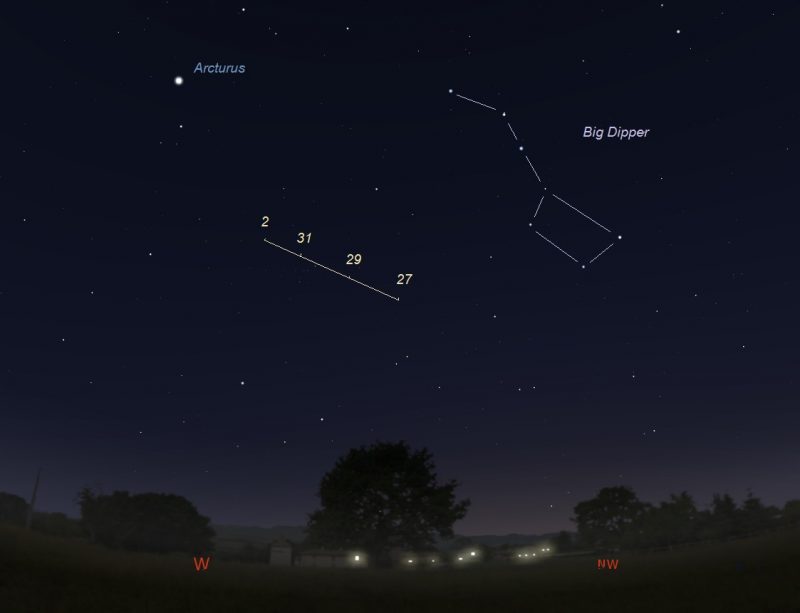
Comet C/2020 F3 (NEOWISE) isn’t what astronomers call a great comet. But it’s a wonderful binocular comet that began gracing our early morning skies in early July. Now it’s visible in the evening, as soon as the sky gets really dark. We’ve been hearing from people throughout the Northern Hemisphere who’ve seen this comet, and we’ve heard from a few who have spotted it from Southern Hemisphere locations.
Comet NEOWISE was closest to Earth on July 23, passing some 64 million miles (103 million km) from our planet. Many observers have reported that – once you spot it with binoculars – you can remove them and glimpse this comet as a fuzzy object, using only the unaided eye.
Using binoculars or other optical aid is a must, though, if you want to see Comet NEOWISE’s splendid split tail. If you don’t have binocs, but do have a good camera, a great alternative is to capture a few-seconds-long exposure image of the approximate area of the sky. Try at different magnification or zoom settings, and the results should reveal the comet’s tail.
Check the bottom of this post for a few photos, but – for many more glorious shots of the comet from people throughout the Northern Hemisphere – visit EarthSky Community Photos. Thank you to all who have submitted photos!
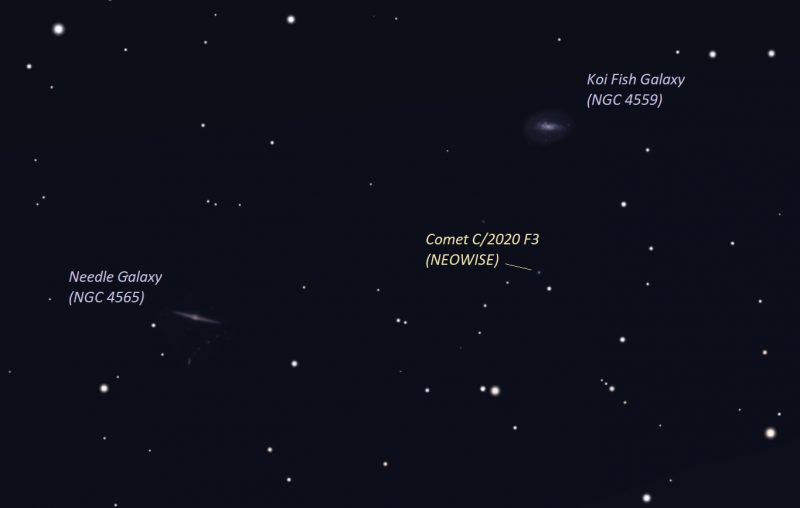


As comet #NEOWISE gets farther away from the Sun, its nucleus gets dimmer as a consequence because it burns less vigorously and the typical turquoise color starts showing. Stack of 40 shots x 25” tracked at 135mm taken last night in the Jura, France. @StormHour @B_Ubiquitous pic.twitter.com/BqhFYIi5FI
— Adrien Mauduit (@NightLights_AM) July 20, 2020



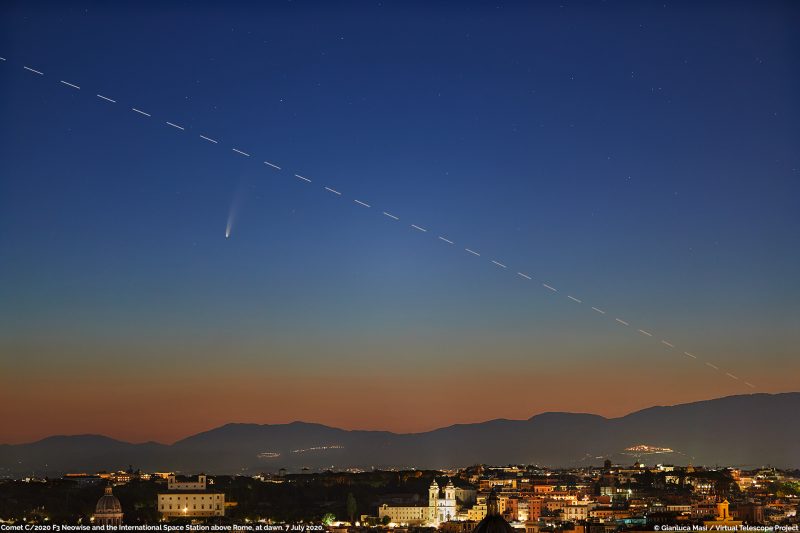


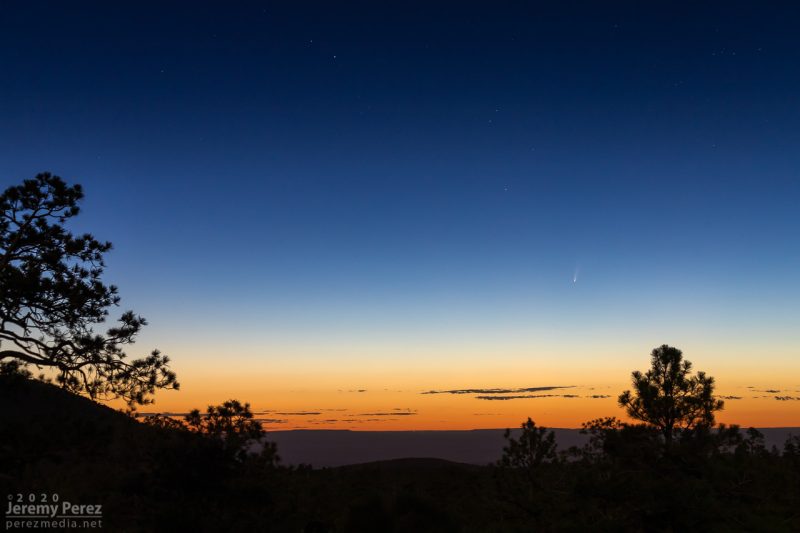
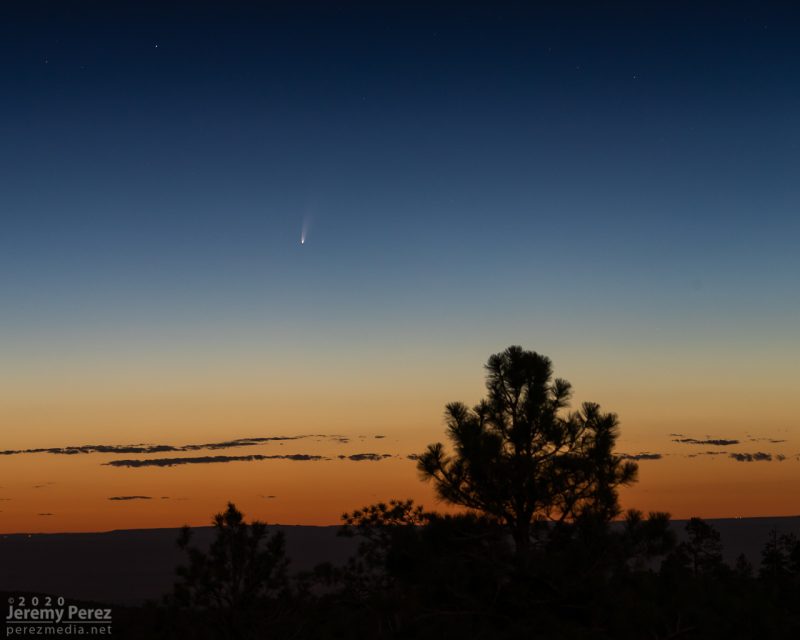
Comet NEOWISE has even been seen from the International Space Station!
Comet NEOWISE from ISS, July 5th pic.twitter.com/pAbGdtchAc
— Seán Doran (@_TheSeaning) July 7, 2020
Russian cosmonaut Ivan Vagner says the comet’s tail is clearly visible from the space laboratory’s cupola. Look at this amazing image:

Alessandro Marchini of the Osservatorio Astronomico Università di Siena posted these photos to Facebook:
Here is another great image by Philipp Salzgeber from Austria:
Comet C/2020 F3 Neowise image taken with 300mm lens, f/5.6, Nikon Z6, 0,4s, ISO 1600 from Wolfurt / Austria. The comet was clearly visible with the unaided eye, it was beautiful in the 10×50 binoculars. #comet #neowise pic.twitter.com/hBGeJZKtie
— Philipp Salzgeber (@astro_graph) July 5, 2020
Niccole Neely posted this photo and said, “Here is another shot of #CometNeowise…this time a bit closer! Look at that beautiful tail! Taken in Arizona this morning!”
When was NEOWISE first discovered? Comet C/2020 F3 (NEOWISE) was discovered on March 27, 2020 – not from Earth’s surface – but from by a space observatory some 326 miles (525 km) above Earth’s surface. It’s named for its discoverer, the Near Earth Object Wide-field Infrared Survey Explorer, aka NEOWISE, which was launched by NASA in 2009.
Comet NEOWISE was closest to the sun on July 3, 2020, passing at about 26.7 million miles (43 million km) from the sun, or a bit closer than the average distance from the sun to Mercury. Unlike some comets, it survived the close encounter with our star and went on to become widely seen by binocular observers and astrophotographers.
How big is Comet NEOWISE? Joseph Masiero, NEOWISE deputy principal investigator at NASA’s Jet Propulsion Laboratory, commented recently:
From its infrared signature, we can tell (its nucleus) is about 3 miles (5 km) across … and is covered with sooty, dark particles left over from its formation near the birth of our solar system 4.6 billion years ago.
In other words … a typical comet!
How bright is Comet NEOWISE? In early July, reports began indicating that Comet NEOWISE has a visual magnitude between 1 and 2. If you know the magnitude scale, where smaller numbers indicate brighter objects, that may sound very bright! However, stars are pinpoints of light, whereas the light of comets is diffuse (spread out). So, for comets, a magnitude of 1 or 2 is fainter than it would be for a star of equal magnitude. The reason is, the comet’s light is distributed over a relatively wide area, instead being concentrated in a single point.
Is Comet NEOWISE a great comet? There’s no strict definition for great comet, but most agree that Hale-Bopp – widely seen by people in 1997 – was one. NEOWISE is nowhere near as bright as Hale-Bopp was. Unlike Hale-Bopp, NEOWISE will never be easily visible to the eye. So it’s not a great comet. But it’s a beautiful binocular comet, absolutely the best comet we’ve had for casual observers in some time.
Don’t miss it.
And, by the way, forget about making plans to view this comet’s next apparition in Earth’s skies. Comet NEOWISE might be visible again from Earth, but not until around the year 8,786!
#Komet C/2020 F3 #NEOWISE und #NLC s über der #Isar und dem #Hinterbrühler See (#München)
Ein wundervolles #Naturschauspiel! pic.twitter.com/0IHjs73RHm
— Astronomie München (@munichspace) July 10, 2020
Long exposure images show even more details:
Cosmic Eruption – Comet NEOWISE looking incredible from Joshua Tree National Park @jackfusco pic.twitter.com/pAwdP6eh9P
— earth is beautiful (@earth__photos) July 12, 2020
What a night! With the potential for some aurora action & Neowise fading day by day, I decided to head up here last night … the comet, bioluminescence, the Milky Way and even a bit of aurora – just wow ?? #Tofino #BC @StormHour pic.twitter.com/woCxumwwVj
— David McColm (@davidlmccolm) July 25, 2020
For a specific view (chart) – on a specific date – from your exact location on the globe, try Stellarium-Web.
Bottom line: Comet C/2020 F3 (NEOWISE) was closest to Earth on July 23. It’s still magnificent now in the evening – through binoculars – for observers in the Northern Hemisphere. A few Southern Hemisphere observers are beginning to capture it, too. Charts and more info here.











